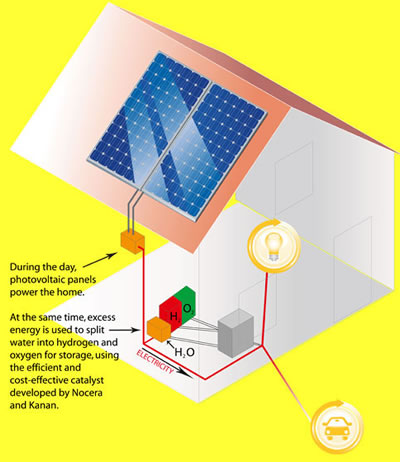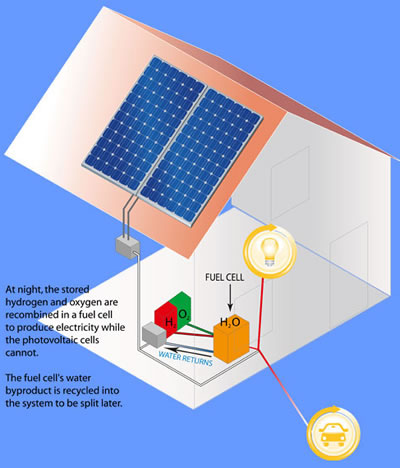Science Fiction
Dictionary
A B C D E F G H I J K L M N O P Q R S T U V W X Y Z
Solar-Powered Fuel Cells Easy As Photosynthesis

A new discovery by MIT scientists lead by Daniel Nocera and Matthew Kanan may make oxygen/hydrogen fuel cells a practical reality.
The key to their discovery is a new catalyst that can produce oxygen gas from water, while another produces hydrogen gas. It consists of consists of cobalt metal, phosphate and an electrode, placed in water. When electricity -- whether from a photovoltaic cell, a wind turbine or any other source -- runs through the electrode, the cobalt and phosphate form a thin film on the electrode, and oxygen gas is produced. The process works at room temperature in neutral pH water; it's easy to set up.
The greatest barrier to the use of fuel cells, which combine hydrogen and oxygen to produce energy and have pure water as a 'waste' product, is the production of hydrogen. Typically, this is done in a way that wastes energy; it burns more energy than it produces.
Nocera and Kanan were inspired by photosynthesis, which is Nature's way of taking the Sun's energy and using it to power the growth of plants and then store that energy.
(MIT energy storage system video w/Nocera interview video)
If this process can be implemented as a consumer product for use in homes, it could make everyone's house a "power plant" and minimizes the need for large power production facilities.
During the daytime, the sun's energy is used to power your house and run MIT's energy process to store energy as hydrogen fuel.

(Store power during the day)
At night, the stored hydrogen can be burned in a fuel cell to provide power for the home, and to charge your electric car for the next day.

(Use the hydrogen in your fuel cell at night)
Experts are greatly impressed with the technique.
"This is a major discovery with enormous implications for the future prosperity of humankind," said Barber, the Ernst Chain Professor of Biochemistry at Imperial College London. "The importance of their discovery cannot be overstated since it opens up the door for developing new technologies for energy production thus reducing our dependence for fossil fuels and addressing the global climate change problem."
Professor Nocera hopes that this technology will be widely available within ten years for homeowners.
From MIT solar revolution.
Scroll down for more stories in the same category. (Story submitted 8/4/2008)
Follow this kind of news @Technovelgy.| Email | RSS | Blog It | Stumble | del.icio.us | Digg | Reddit |
Would
you like to contribute a story tip?
It's easy:
Get the URL of the story, and the related sf author, and add
it here.
Comment/Join discussion ( 5 )
Related News Stories - (" Engineering ")
Roborock Saros Z70 Is A Robot Vacuum With An Arm
'Anything larger than a BB shot it picked up and placed in a tray...' - Robert Heinlein, 1956.
Secret Kill Switch Found In Yutong Buses
'The car faltered as the external command came to brake...' - Keith Laumer, 1965.
The Desert Ship Sailed In Imagination
'Across the ancient sea floor a dozen tall, blue-sailed Martian sand ships floated, like blue smoke.' - Ray Bradbury, 1950.
The Zapata Air Scooter Would Be Great In A Science Fiction Story
'Betty's slapdash style.'
Technovelgy (that's tech-novel-gee!) is devoted to the creative science inventions and ideas of sf authors. Look for the Invention Category that interests you, the Glossary, the Invention Timeline, or see what's New.
Science Fiction
Timeline
1600-1899
1900-1939
1940's 1950's
1960's 1970's
1980's 1990's
2000's 2010's
Current News
Golf Ball Test Robot Wears Them Out
"The robot solemnly hit a ball against the wall, picked it up and teed it, hit it again, over and again...'
Boring Company Vegas Loop Like Asimov Said
'There was a wall ahead... It was riddled with holes that were the mouths of tunnels.'
Rigid Metallic Clothing From Science Fiction To You
'...support the interior human structure against Jupiterís pull.'
Is The Seattle Ultrasonics C-200 A Heinlein Vibroblade?
'It ain't a vibroblade. It's steel. Messy.'
Roborock Saros Z70 Is A Robot Vacuum With An Arm
'Anything larger than a BB shot it picked up and placed in a tray...'
A Beautiful Visualization Of Compact Food
'The German chemists have discovered how to supply the needed elements in compact, undiluted form...'
Bone-Building Drug Evenity Approved
'Compounds devised by the biochemists for the rapid building of bone...'
Secret Kill Switch Found In Yutong Buses
'The car faltered as the external command came to brake...'
Inmotion Electric Unicycle In Combat
'It is about the size and shape of a kitchen stool, gyro-stabilized...'
Grok Scores Best In Psychological Tests
'Try to find out how he ticks...'
PaXini Supersensitive Robot Fingers
'My fingers are not that sensitive...'
Congress Considers Automatic Emergency Braking, One Hundred Years Too Late
'The greatest problem of all was the elimination of the human element of braking together with its inevitable time lag.'
The Desert Ship Sailed In Imagination
'Across the ancient sea floor a dozen tall, blue-sailed Martian sand ships floated, like blue smoke.'
The Zapata Air Scooter Would Be Great In A Science Fiction Story
'Betty's slapdash style.'
Thermostabilized Wet Meat Product (NASA Prototype)
There are no orbiting Michelin stars. Yet.
Could Crystal Batteries Generate Power For Centuries?
'Power could be compressed thus into an inch-square cube of what looked like blue-white ice'
